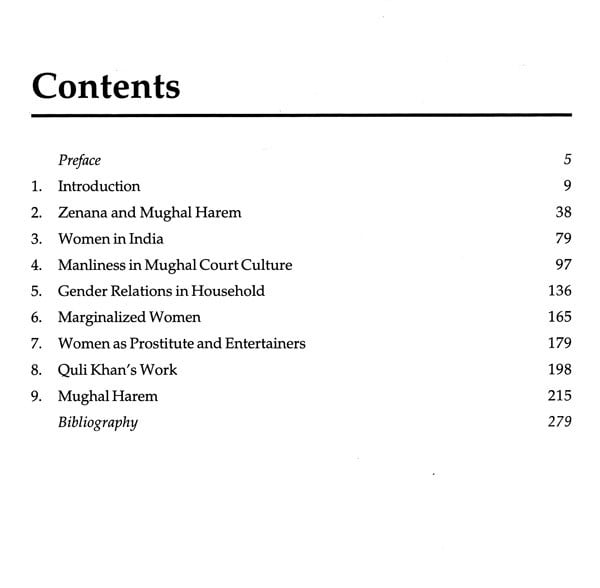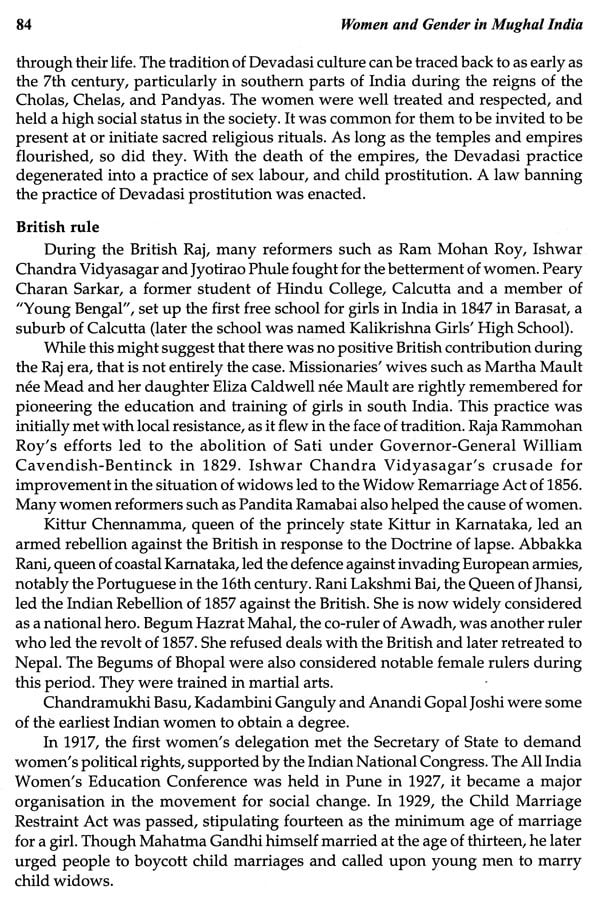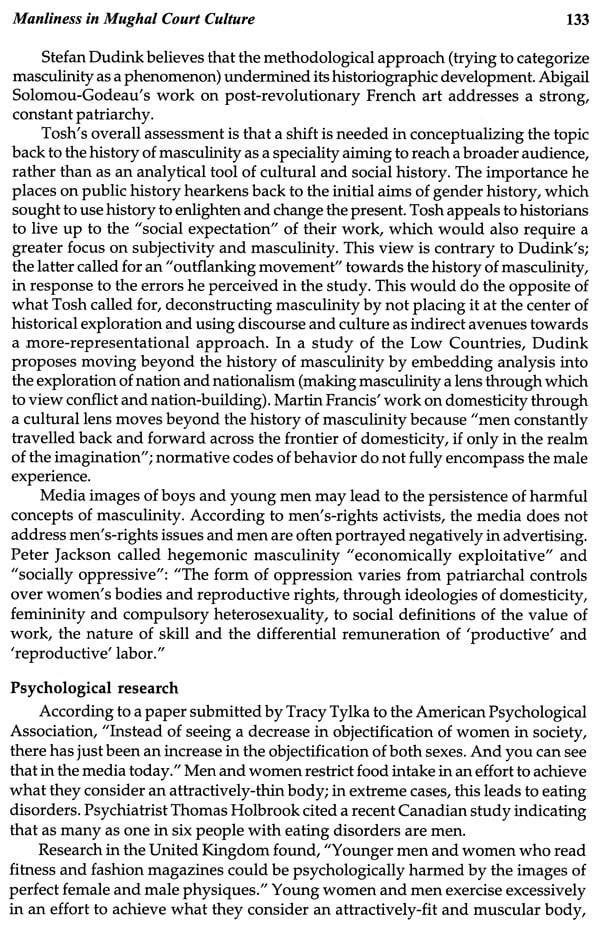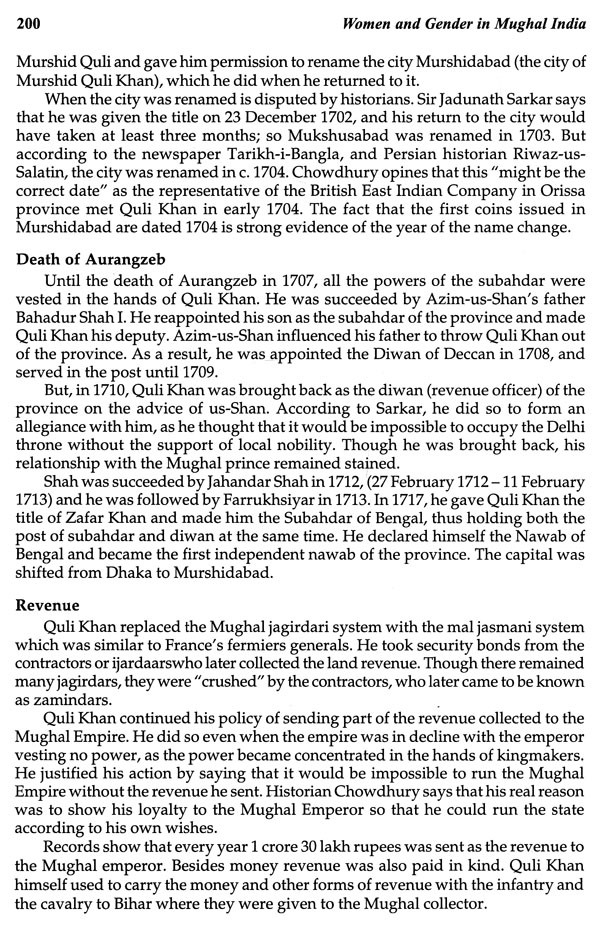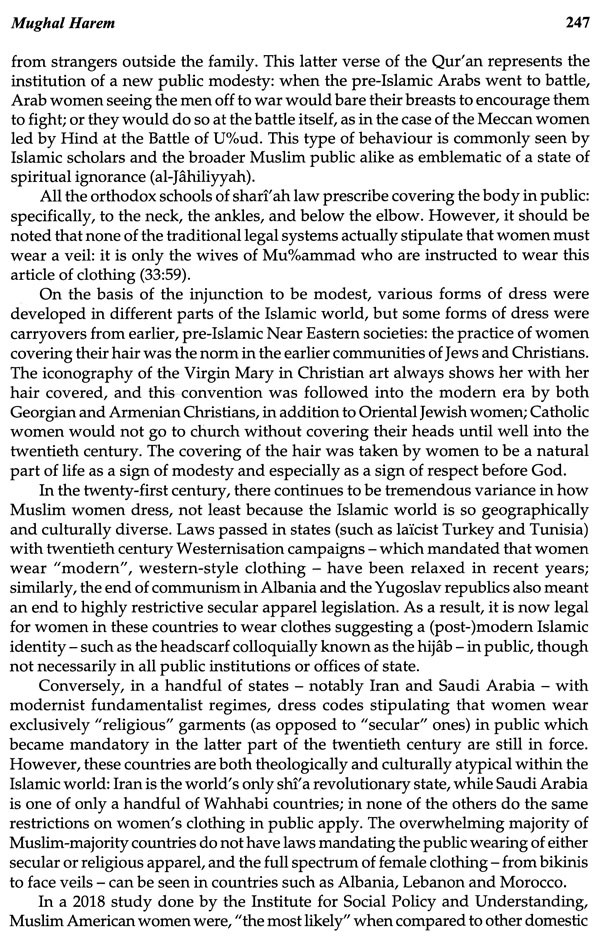
Women and Gender in Mughal India
Book Specification
| Item Code: | UAR507 |
| Author: | Amrendra Verma |
| Publisher: | Edukeen Publisher |
| Language: | English |
| Edition: | 2019 |
| ISBN: | 9789389387551 |
| Pages: | 280 |
| Cover: | HARDCOVER |
| Other Details | 9.50 X 6.50 inch |
| Weight | 560 gm |
Book Description
Read this book to learn about the position of women during Mughal period. The position of women in India was much inferior to men during the period of the Sultanate and they suffered from many social evils and other handicaps. Primarily, the women were regarded as articles of pleasure. Devadasi system was another social evil which was prevalent among the Hindus. The book deals with different essential topics on Women and gender in Mughal India. The aim of this book is to provide a generalized survey of the women condition during mughal period in Indian. This book is very important in understanding social condition of mughal period.
Amrendra Verma (born on 28th July, 1973 at Allahabad) graduated from Allahabad University, Allahabad with First Class Honours with Distinction in History. He did his M.A. in History from Allahabad University, Allahabad securing First Class Second position. He holds Ph.D. degree in History from Allahabad university, Allahabad. He is a good teacher and a researcher. He has taught in different colleges under different universities for a decade. He has written about four books on History and Political Science. He has contributed more than ten papers to leading Journals as well as to different books and newspapers.
The Mansabdar was a military unit within the administrative system of the Mughal Empire introduced by Akbar. The word mansab is of Arabic origin meaning rank or position. The system, hence, determined the rank of a government official and also other military generals. Every civil and military officer was given a 'mansab' and different which could be increased by ten were used for ranking officers [clarification needed] It also determined the salaries and allowances of officers. The term manasabadar means a person who has a positioning or ranking of a government can give power.
In Mansabdari system founded by Akbar, The Mansabdars were Military Commanders, High Civil and Military officers, and Provincial Governors.
It was a system whereby nobles were granted the rights to hold a jagir, or revenue assignments (not land itself) for services rendered by them, with the direct control of these nobles in the hands of the king. Abu'l Fadl has mentioned 66 grades of mansabdars but in practice there were not more than 33 mansabs. During the early reign of Akbar, the lowest grade was ten and the highest was 12,000. Higher mansabs were given to princes and Rajput rulers who accepted the suzerainty of the emperor.
The Mughal Empire or Mogul Empire was an empire in the Indian subcontinent, founded in 1526. It was established and ruled by the Timurid dynasty, with Turco Mongol Chagatairoots from Central Asia, claiming direct descent from both Genghis Khan (through his son Chagatai Khan) and Timur, and with significant Indian Rajput and Persian ancestry through marriage alliances; the first two Mughal emperors had both parents from Central Asian ancestry. The dynasty combined Persianate culture with local Indian cultural influences visible in its court culture and administrative customs.
The beginning of the empire is conventionally dated to the victory by its founder Babur over Ibrahim Lodi, the last ruler of the Delhi Sultanate, in the First Battle of Panipat (1526). During the reign of Humayun, the successor of Babur, the empire was briefly interrupted by the Sur Empire established by Sher Shah Suri. The "classic period" of the Mughal Empire began in 1556, with the ascension of Akbar to the throne. Some Rajput kingdoms continued to pose a significant threat to the Mughal dominance of northwestern India, but most of them were subdued by Akbar. All Mughal emperors were Muslims; Akbar, however, propounded a syncretic religion in the latter part of his life called Din-i Ilahi, as recorded in historical books like Ain-i-Akbari and Dabistan-i Mazahib. The Mughal Empire did not try to intervene in native societies during most of its existence, rather co opting and pacifying them through concilliatory administrative practices and a syncretic, inclusive ruling elite, leading to more systematic, centralized and uniform rule. Traditional and newly coherent social groups in northern and western India, such as the Marathas, the Rajputs, the Pashtuns, the Hindu Jats and the Sikhs, gained military and governing ambitions during Mughal rule which, through collaboration or adversity, gave them both recognition and military experience.
Internal dissatisfaction arose due to the weakness of the empire's administrative and economic systems, leading to its break-up and declarations of independence of its former provinces by the Nawab of Bengal, the Nawab of Awadh, the Nizam of Hyderabad and other small states. In 1739, the Mughals were crushingly defeated in the Battle of Karnal by the forces of Nader Shah, the founder of the Afsharid dynasty in Persia, and Delhi was sacked and looted, drastically accelerating their decline. By the mid-18th century, the Marathas had routed Mughal armies and won over several Mughal provinces from the Punjab to Bengal. During the following century Mughal power had become severely limited, and the last emperor, Bahadur Shah II, had authority over only the city of Shahjahanabad. Bahadur issued a firman supporting the Indian Rebellion of 1857. Consequent to the rebellion's defeat he was tried by the British East India Company for treason, imprisoned, and exiled to Rangoon. The last remnants of the empire were formally taken over by the British, and the British Parliament passed the Government of India Act 1858 to enable the Crown formally to displace the rights of the East India Company and assume direct control of India in the form of the new British Raj.
At its height, the Mughal Empire stretched from Kabul, Afghanistan in the west to Arakan, Myanmar in the east, and from Kashmir in the north to the Deccan Plateau in the south, extending over nearly all of the Indian subcontinent. It was the third largest empire in the Indian subcontinent (behind the Maurya Empire and the British Raj), spanning approximately four million square kilometers at its zenith, 122% of the size of the modern Republic of India. The maximum expansion was reached during the reign of Aurangzeb, who ruled over more than 150 million subjects, nearly 25% of the world's population at the time. The Mughal Empire also ushered in a period of proto-industrialization, and around the 17th century, Mughal India became the world's largest economic and manufacturing power, responsible for 25% of global industrial output until the 18th century. The Mughal Empire is considered "India's last golden age" and one of the three Islamic Gunpowder Empires (along with the Ottoman Empire and Safavid Iran). The reign of Shah Jahan (1628-1658) represented the height of Mughal architecture, with famous monuments such as the Taj Mahal, Moti Masjid, Red Fort, Jama Masjid and Lahore Fort being constructed during his reign.
**Contents and Sample Pages**

